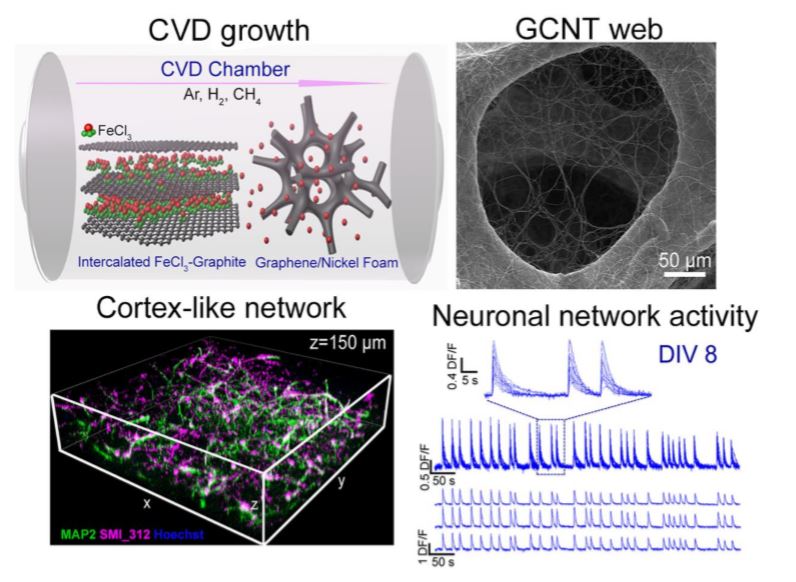Video Article Open Access
A Fully 3D Interconnected Graphene-Carbon Nanotube Web Allows the Study of Glioma Infiltration in Bioengineered 3D Cortex-Like Networks
Miao Xiao1,2,*, Francesco Paolo Ulloa Severino2, Xiaoyun Li2, Qin Song2, Guosheng Cheng3, Vincent Torre2
1Institute for Cardiovascular Science & Department of Cardiovascular Surgery of the First Affiliated Hospital, Medical College, Soochow University, Suzhou, 215000, China
2International School for Advanced Studies (SISSA), via Bonomea 265, Trieste 34136, Italy.
3CAS Key Laboratory of Nano-Bio Interface, Suzhou Institute of Nano-tech and Nano-bionics, Chinese Academy of Sciences, 398 Ruoshui Road, Suzhou Industrial Park, Jiangsu 215123, China.
Vid. Proc. Adv. Mater., Volume 2, Article ID 2021-0159 (2021)
DOI: 10.5185/vpoam.2021.0159
Publication Date (Web): 09 Feb 2021
Copyright © IAAM
Graphical Abstract

Abstract
Currently available three-dimensional (3D) assemblies based on carbon nanotubes (CNTs) lag far behind their two-dimensional CNT-based bricks and require major improvements for biological applications. By using Fe nanoparticles confined to the interlamination of graphite as catalyst, we have obtained a fully 3D interconnected CNT web through the pores of graphene foam (GCNT web) by in situ chemical vapor deposition. This 3D GCNT web has a thickness up to 1.5 mm and a completely geometric, mechanical and electrical interconnectivity. Dissociated cortical cells cultured inside the GCNT web form a functional 3D cortex-like network exhibiting a spontaneous electrical activity that is closer to what is observed in vivo. By co-culturing and fluorescently labelling glioma and healthy cortical cells with different colours, a new in vitro model is obtained to investigate malignant glioma infiltration. This model allows to reconstruct the 3D trajectories and velocity distribution of individual infiltrating glioma with an unprecedented precision. The model is cost-effective and allows a quantitative and rigorous screening of anti-cancer drugs. Our fully 3D interconnected GCNT web is biocompatible and is an ideal tool to study 3D biological processes in vitro representing a pivotal step towards precise and personalized medicine.
Keywords
3D GCNT web, neuronal network, malignant glioma infiltration.
Acknowledgement
This work was supported by the funds from National Key Basic Research Program of China (973 Program grant no. 2014CB965003), Key Research and Development Program of Jiangsu Province (BE2017665), Regione FVG (Italy) for the project “GLIOBLASTOMA - Infiltrazione nei gliomi: nuovo target terapeutico”, the 3315 Innovative Teams Program of Ningbo – China.
References
- M. Xiao, T. Kong, W. Wang, Q. Song, D. Zhang, Q. Ma, G. Cheng, Advanced Functional Materials; 2015, 25, 6165
Biography
Miao Xiao is a lecturer in Soochow University, Suzhou, China. He got his PhD from International School for Advanced Studies (SISSA), Italy under the supervision of Prof. Vincent Torre. His research interests focus on 3D carbon-based material assemblies and their applications in Neurobiology and cancer researches. Related works have been published as insider cover in Advanced Materials (2018, 30 (52),1806132) and Advanced Functional Materials (2015, 25 (39), 6150) and also Biomaterials (2016, 106, 193-204). Now he has joined in Soochow University and work in Institute for Cardiovascular Science. His focus is on the study of 3D carbon-based material's application in human induced pluripotent stem cell-derived cardiomyocytes (hiPSC-CMs).
Video Proceedings of Advanced Materials

Upcoming Congress



